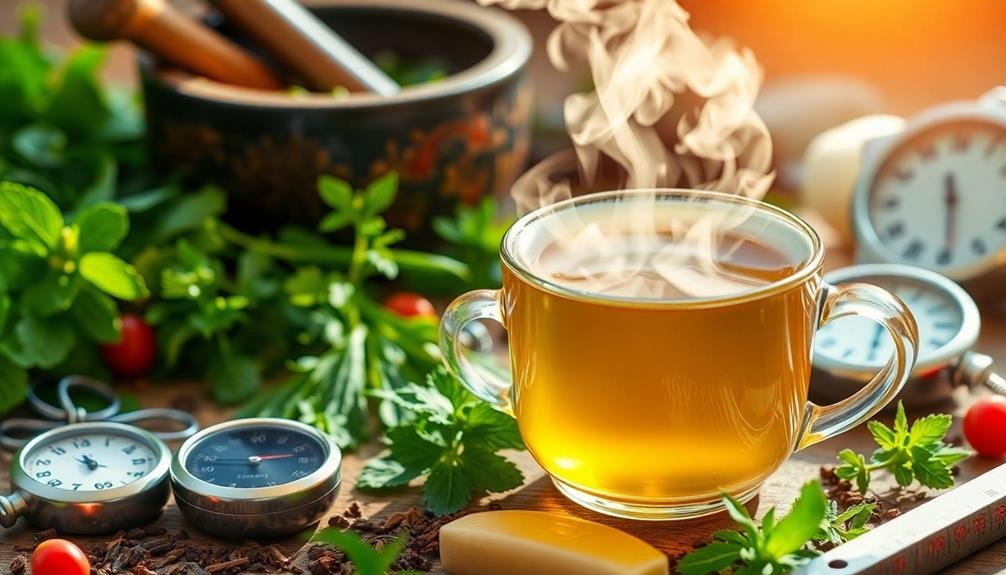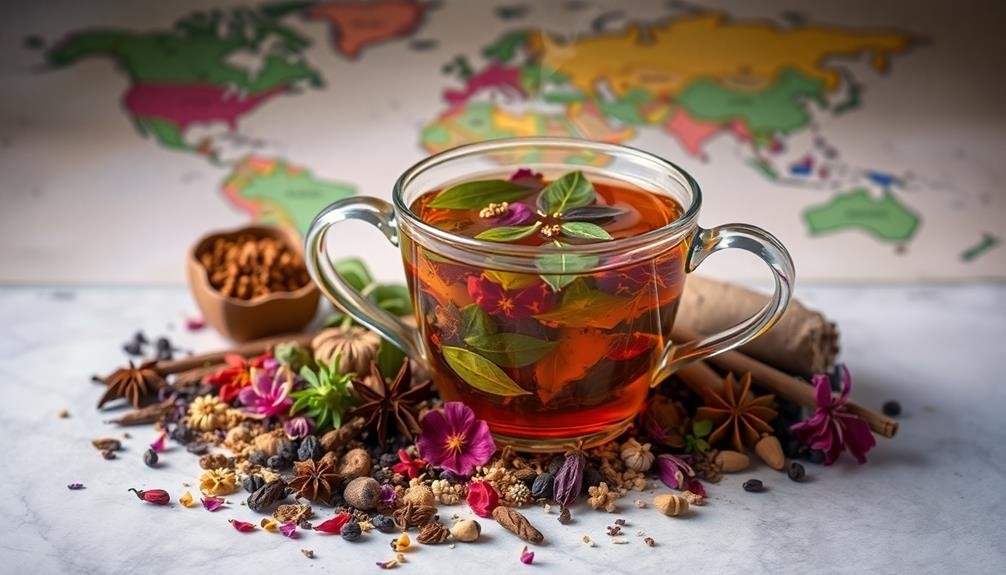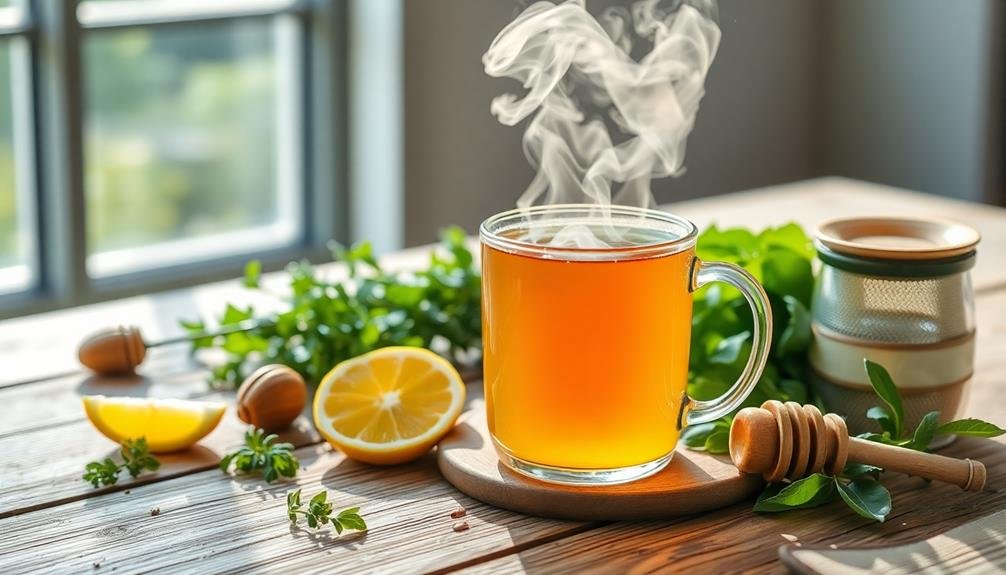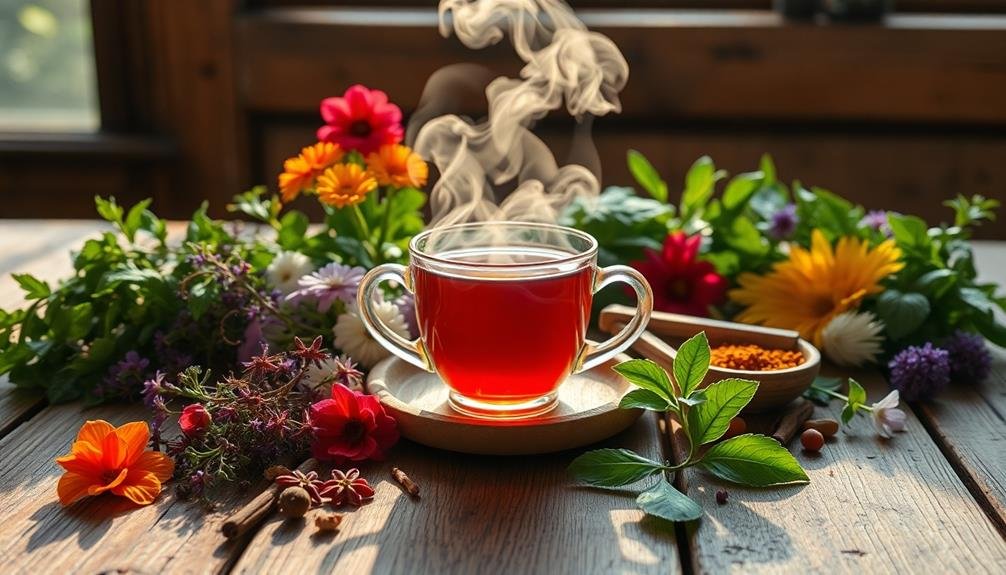Enhancing your herbal tea's flavor and potency can transform your daily brew into a powerful wellness ritual. By maximizing herb potency and nutrient absorption, you'll boost the health benefits of your tea. You can tailor blends to your taste preferences and specific health concerns, creating a personalized experience. Seasonal adaptations and aromatherapy techniques add depth to your tea routine, engaging multiple senses. Improved visual appeal makes your tea more inviting, while proper storage extends the life of your blends. With eco-friendly methods, you'll elevate your tea experience while supporting sustainability. Discover how to release the full potential of your herbal brews.
Health Benefits of Enhanced Teas

While traditional herbal teas offer numerous health benefits, enhanced versions can pack an even more powerful punch. By boosting the flavor and potency of your herbal tea, you're not just improving its taste but also maximizing its therapeutic potential.
Enhanced teas often contain higher concentrations of beneficial compounds, which can lead to more pronounced effects on your health. You'll find that these upgraded brews can provide stronger antioxidant protection, helping to combat free radicals and reduce inflammation in your body.
They may also offer improved digestive support, as enhanced herbs can more effectively soothe an upset stomach or promote healthy gut function. If you're looking for better stress relief or improved sleep, potent herbal blends can deliver more noticeable calming effects.
Enhanced teas can also boost your immune system more effectively, giving you a better defense against common illnesses. Some may even provide increased cognitive benefits, enhancing focus and mental clarity.
Personalized Flavor Profiles
Enhancing herbal teas isn't just about boosting their health benefits; it's also about creating a flavor profile that suits your unique tastes. By experimenting with different herbs, spices, and natural sweeteners, you'll discover combinations that tantalize your taste buds and keep you coming back for more.
Start by identifying your preferred flavor profile: Do you enjoy sweet, spicy, or earthy notes? Then, explore complementary ingredients that enhance these qualities. For example, if you love chamomile tea, try adding a touch of lavender for a soothing floral blend, or ginger for a spicy kick.
| Base Tea | Sweet Addition | Spicy Addition | Earthy Addition |
|---|---|---|---|
| Chamomile | Honey | Cinnamon | Sage |
| Peppermint | Stevia | Ginger | Nettle |
| Rooibos | Vanilla | Cardamom | Dandelion Root |
Don't be afraid to mix and match. You might discover unexpected combinations that become your new favorites. Keep a tea journal to track your experiments and refine your personal blends. Remember, the goal is to create a tea that not only nourishes your body but also delights your senses, making each cup a truly personalized experience.
Maximizing Herb Potency

After perfecting your flavor profile, it's important to focus on maximizing the potency of your herbal tea. To achieve this, you'll need to understand the factors that influence herb potency and implement techniques to preserve their medicinal properties.
Start by selecting high-quality, fresh herbs from reputable sources. Proper storage is imperative; keep your herbs in airtight containers away from light, heat, and moisture. When preparing your tea, use the correct water temperature for each herb to avoid destroying delicate compounds. Steeping time also plays a crucial role in extracting the full potential of your herbs.
To further enhance potency, consider these methods:
- Crush or grind herbs just before use to release more essential oils
- Combine complementary herbs that work synergistically
- Use a tea infuser or French press to allow for longer steeping times
- Add a splash of lemon juice to increase the bioavailability of certain compounds
- Experiment with cold brewing for a gentler extraction process
Seasonal Adaptations for Tea Blends
You can tailor your herbal tea blends to match the seasons, enhancing both flavor and enjoyment.
In spring, embrace light and floral notes to awaken your senses, while summer calls for cooling herbal infusions to beat the heat.
As autumn arrives, shift towards warming spice blends that comfort and soothe during cooler days.
Spring: Light, Floral Notes
As spring blossoms unfold, herbal tea enthusiasts can embrace the season's light and floral notes in their blends. You'll find that incorporating springtime elements into your teas can elevate both flavor and aroma, creating a revitalizing and invigorating experience.
Consider adding delicate flowers like chamomile, lavender, or rose petals to your base tea for a subtle floral touch. These additions not only enhance the taste but also provide potential health benefits.
To fully capture the essence of spring in your herbal tea, experiment with these light and floral ingredients:
- Elderflower: Adds a sweet, honey-like flavor
- Lemon balm: Offers a mild citrusy note
- Jasmine: Imparts a delicate, exotic aroma
- Hibiscus: Provides a tart, cranberry-like taste
- Honeysuckle: Contributes a sweet, nectar-like flavor
When blending these spring-inspired ingredients, remember to balance the flavors carefully. Start with small amounts and adjust to your taste preferences.
You can also incorporate fresh herbs like mint or lemon verbena for an extra layer of complexity. By embracing the season's bounty, you'll create unique and revitalizing herbal tea blends that capture the essence of spring in every sip.
Summer: Cooling Herbal Infusions
During the sweltering summer months, cooling herbal infusions become essential for tea enthusiasts seeking refreshment. You'll want to focus on herbs and botanicals that naturally cool the body and provide a respite from the heat.
Mint varieties, such as peppermint and spearmint, are excellent choices for their cooling properties and invigorating flavors. Incorporate lemon balm for its citrusy notes and calming effects, or add hibiscus for a tart, fruity taste that's rich in vitamin C.
To enhance your summer blends, consider including herbs like chamomile for its soothing qualities, or lemongrass for a subtle citrus undertone. You can also experiment with floral notes by adding lavender or rose petals, which pair well with cooling herbs.
For an extra burst of flavor, try infusing your tea with fresh fruits like strawberries, peaches, or watermelon. These additions not only improve taste but also increase the tea's nutritional value.
Don't forget to adjust your brewing method for summer infusions. Cold brewing or making sun tea can result in a smoother, less bitter flavor profile that's perfect for hot days.
Autumn: Warming Spice Blends
Autumn's crisp air and falling leaves signal the perfect time to shift your herbal tea blends to warming spice combinations. As the temperature drops, you'll want to create infusions that comfort and nourish your body from the inside out.
Incorporate classic fall spices like cinnamon, ginger, and cloves to boost circulation and warm your core. These spices not only add depth to your tea's flavor but also provide numerous health benefits.
To create the perfect autumn herbal tea blend, consider these warming spices and herbs:
- Cinnamon: Improves circulation and aids digestion
- Ginger: Reduces inflammation and boosts immunity
- Cloves: Offers antimicrobial properties and relieves pain
- Cardamom: Supports respiratory health and eases stomach discomfort
- Star anise: Provides antioxidants and helps with sleep
Experiment with different combinations of these spices to find your ideal autumn blend. You can also add a touch of sweetness with dried apple pieces or a hint of vanilla.
Don't forget to include a base herb like rooibos or black tea for a well-rounded flavor profile. By tailoring your herbal tea to the season, you'll maximize its flavor and potency while supporting your body's changing needs.
Aromatherapy Through Tea Enhancement

You can elevate your tea experience by incorporating aromatherapy principles through essential oils.
By adding a drop or two of calming scents like lavender or chamomile, you'll enhance both the flavor and therapeutic potential of your brew.
This sensory amplification transforms your tea ritual into a holistic wellness practice, engaging multiple senses simultaneously.
Essential Oils for Tea
The allure of essential oils extends beyond traditional aromatherapy, offering a unique way to enhance your herbal tea experience. By adding a few drops of carefully selected essential oils to your brew, you'll elevate both flavor and therapeutic benefits.
Remember to use food-grade oils and start with small amounts, as they're highly concentrated.
Here are some essential oils that pair well with herbal teas:
- Peppermint: Adds a revitalizing kick to chamomile or green tea
- Lavender: Complements floral teas like hibiscus or rose
- Lemon: Brightens up black tea or rooibos
- Ginger: Enhances spicy chai or turmeric blends
- Bergamot: Gives an Earl Grey-like twist to any tea
When incorporating essential oils into your tea, you're not just boosting flavor; you're also harnessing their potential health benefits.
For example, peppermint can aid digestion, while lavender may promote relaxation. It's vital to research each oil's properties and potential interactions before use.
Calming Scents and Flavors
Countless herbal teas offer calming scents and flavors that can enhance your aromatherapy experience. By selecting the right herbs and essential oils, you'll create a soothing blend that relaxes both your mind and body.
Lavender, chamomile, and lemon balm are popular choices for their calming properties. These herbs not only taste delightful but also release aromatic compounds that promote relaxation.
You can amplify these effects by adding a drop or two of essential oils to your tea. Vanilla, bergamot, and ylang-ylang are excellent options for creating a sense of tranquility.
When you inhale these scents while sipping your tea, you'll engage multiple senses, deepening the calming experience. Remember to use food-grade essential oils and add them sparingly to avoid overpowering the tea's natural flavors.
For an extra touch of serenity, try pairing your enhanced tea with calming activities like meditation or gentle stretching. You'll find that the combination of aromatherapy and mindfulness can considerably reduce stress and improve your overall well-being.
Experiment with different herb and oil combinations to discover your perfect calming blend.
Sensory Experience Amplified
While sipping a well-crafted herbal tea can be a delightful experience on its own, enhancing your brew with aromatherapy techniques can elevate it to new sensory heights.
By incorporating essential oils or dried herbs, you'll create a multi-sensory experience that engages both taste and smell. This amplification of your tea's aroma can enhance its therapeutic effects, promoting relaxation and mindfulness.
To amplify your tea's sensory experience:
- Add a drop of food-grade essential oil to your cup
- Steep dried lavender or chamomile with your tea leaves
- Float fresh mint or lemon balm leaves on the surface
- Use a tea infuser filled with aromatic spices like cinnamon or cardamom
- Burn incense or light a scented candle while sipping your tea
As you inhale the enhanced aromas, you'll notice a deeper connection to your tea's flavors and effects.
This practice can turn your tea-drinking ritual into a form of aromatherapy, potentially boosting mood and reducing stress.
You'll find that the amplified sensory experience makes your tea time more memorable and satisfying, encouraging you to slow down and fully appreciate the moment.
Balancing Taste and Medicinal Properties
Striking a delicate balance between taste and medicinal properties is essential when enhancing herbal tea. You'll want to guarantee that your brew remains effective while still being enjoyable to drink.
Start by identifying the primary herbs and their therapeutic benefits. Then, consider complementary flavors that won't overpower or diminish these properties.
For bitter herbs, add a touch of honey or stevia to soften the taste without masking their medicinal effects. If you're using strong-tasting herbs like valerian or licorice root, blend them with milder, aromatic options such as chamomile or lavender. This approach maintains potency while creating a more palatable infusion.
Don't forget about temperature and steeping time. Some herbs release their medicinal compounds at different rates, so experiment to find the sweet spot where flavor and potency align.
You can also try cold brewing for a smoother taste that preserves delicate flavors and nutrients.
Exploring Global Tea Traditions

You'll find ancient tea brewing rituals across cultures offer unique insights into enhancing flavor and potency.
From the Japanese tea ceremony to Chinese gongfu tea preparation, these traditions emphasize mindfulness and precision in brewing methods.
Ancient Tea Brewing Rituals
Throughout history, civilizations have developed intricate rituals for brewing and serving tea, each reflecting unique cultural values and traditions.
These ancient practices offer valuable insights into enhancing your herbal tea's flavor and potency.
You'll find that many ancient tea rituals emphasize mindfulness and precision. In Japan's chanoyu ceremony, every movement is deliberate, from the way the tea is whisked to how the cup is presented.
This attention to detail can greatly improve your tea's taste and effectiveness.
Ancient Chinese tea ceremonies often involve multiple infusions of the same leaves, revealing different flavors and properties with each steep.
By adopting this practice, you'll extract more benefits from your herbs and experience a wider range of tastes.
Consider incorporating these elements from ancient tea rituals:
- Use specific water temperatures for different herbs
- Allow tea to steep for precise durations
- Serve in particular vessels that complement the tea
- Pair teas with complementary foods or sweets
- Create a serene environment for tea preparation and consumption
Cultural Infusion Techniques
Building on these ancient rituals, let's explore diverse cultural infusion techniques from around the world. You'll find that different cultures have developed unique methods to enhance their herbal teas' flavor and potency.
In Morocco, you'll encounter the art of "atai," where green tea is brewed with fresh mint and sugar. The tea is poured from a height to create a frothy texture and aerate the brew.
In Japan, the matcha ceremony involves whisking powdered green tea with hot water using a bamboo whisk, resulting in a smooth, frothy drink.
Russian tea culture introduces the samovar, a heated metal container that keeps water hot while a concentrated tea brew sits atop it. You'll mix the two to your desired strength.
In Tibet, you'll discover butter tea, where tea leaves are boiled for hours before being mixed with yak butter and salt, creating a rich, energizing beverage.
Indian masala chai combines black tea with aromatic spices like cardamom, cinnamon, and ginger, often simmered with milk for a comforting drink.
Nutrient Absorption and Bioavailability
After steeping your herbal tea, the next essential step is maximizing its nutritional benefits. To enhance nutrient absorption and bioavailability, you'll want to focus on methods that increase your body's ability to utilize the beneficial compounds in your tea.
One effective technique is to add a small amount of fat to your tea. This can be in the form of coconut oil, ghee, or even a splash of full-fat milk. Fat helps your body absorb fat-soluble vitamins and phytochemicals more efficiently.
You can also boost absorption by including vitamin C-rich foods alongside your tea, as this enhances the uptake of certain antioxidants.
Consider these additional strategies to improve nutrient absorption:
- Pair your tea with fermented foods to increase probiotic content
- Use freshly boiled water to extract more beneficial compounds
- Add a pinch of black pepper to enhance the bioavailability of certain nutrients
- Consume your tea with a meal to aid in digestion and nutrient uptake
- Choose organic herbs to minimize exposure to pesticides that may interfere with absorption
Synergistic Herb Combinations

Herb synergy is the key to creating potent and flavorful herbal teas. By combining complementary herbs, you'll reveal enhanced therapeutic benefits and taste profiles that surpass individual ingredients.
Think about pairing adaptogenic herbs like ashwagandha with nervines such as chamomile to create a powerful stress-relieving blend. For digestive support, combine carminative herbs like peppermint with bitter herbs like dandelion root.
When crafting synergistic blends, pay attention to flavor balance. Combine strong-tasting herbs with milder ones to create a harmonious taste. For instance, pair the bold flavor of ginger with the subtle sweetness of licorice root.
You can also enhance the overall potency by including herbs that aid absorption, such as black pepper or ginger.
Experiment with different ratios to find the perfect balance for your taste and health goals. Start with a base herb that aligns with your primary intention, then add smaller amounts of complementary herbs.
Don't forget to think about the therapeutic actions of each herb to guarantee they work together synergistically. By mastering the art of herb synergy, you'll create herbal tea blends that are both delicious and highly effective.
Addressing Specific Health Concerns
With a well-crafted herbal tea blend, you can target specific health concerns effectively. By combining herbs known for their medicinal properties, you'll create a powerful and tasty remedy tailored to your needs.
Whether you're looking to boost your immune system, improve digestion, or reduce stress, there's a perfect herbal combination waiting for you.
When addressing specific health concerns through herbal tea, consider these key factors:
- Identify your primary health goal
- Research herbs known to support that goal
- Consult with a healthcare professional or herbalist
- Start with small amounts and observe your body's response
- Adjust the blend as needed for ideal results
Enhancing Tea's Visual Appeal

The visual appeal of your herbal tea can elevate the entire drinking experience. When you present your tea in an attractive manner, you're not only pleasing your taste buds but also engaging your sense of sight. This can enhance your overall enjoyment and even influence your perception of the tea's flavor.
To boost your tea's visual appeal, consider these elements:
| Element | Technique | Effect |
|---|---|---|
| Color | Use vibrant herbs | Creates eye-catching hues |
| Texture | Add floating petals | Adds dimension and interest |
| Clarity | Strain thoroughly | Guarantees a clean, clear appearance |
You can also experiment with different serving vessels. Clear glass cups or teapots allow you to appreciate the tea's color and any added botanicals. For a more traditional look, opt for delicate porcelain or ceramic teaware. Don't forget about garnishes – a sprig of fresh mint, a slice of lemon, or a cinnamon stick can add both visual interest and complementary flavors. By paying attention to these details, you'll transform your herbal tea from a simple drink into a visually appealing and Instagram-worthy experience.
Prolonging Shelf Life of Blends
While creating visually appealing teas is rewarding, preserving their quality over time is equally important. To prolong the shelf life of your herbal tea blends, you'll need to focus on proper storage and handling techniques.
Start by ensuring your herbs are completely dry before blending, as moisture can lead to mold growth and spoilage.
Store your tea blends in airtight containers, away from direct sunlight, heat, and strong odors. Glass jars or opaque, food-grade containers work well. Label each blend with its contents and the date it was created to track freshness. Regularly inspect your teas for signs of degradation, such as changes in color, aroma, or texture.
To further extend the shelf life of your blends, consider these tips:
- Use whole herbs instead of powdered forms when possible
- Add natural preservatives like dried citrus peels or rosehips
- Vacuum seal larger quantities for long-term storage
- Store blends in a cool, dry place with consistent temperature
- Avoid touching the herbs with your hands; use clean utensils instead
Eco-Friendly Tea Enhancement Methods

As you explore ways to enhance your herbal tea's flavor and potency, it's crucial to take into account eco-friendly methods that minimize environmental impact. Consider using solar dehydration for your herbs, which preserves their natural flavors and active compounds without consuming electricity. You can also experiment with cold brewing, a process that extracts flavors gently and reduces energy usage.
Opt for reusable tea bags or infusers made from sustainable materials like organic cotton or stainless steel. These alternatives eliminate single-use plastic waste and allow for better flavor extraction. When sourcing herbs, choose locally grown or wildcrafted varieties to reduce transportation emissions and support biodiversity.
| Method | Benefits | Environmental Impact |
|---|---|---|
| Solar Dehydration | Preserves flavors and compounds | Zero energy consumption |
| Cold Brewing | Gentle extraction, less bitter | Reduced energy use |
| Reusable Infusers | Better flavor, no waste | Eliminates single-use plastics |
Incorporate natural flavor enhancers like citrus peels, spices, or edible flowers to boost your tea's taste profile without artificial additives. You can also try fermenting certain herbs to develop unique flavors and increase their nutritional value. By adopting these eco-friendly enhancement methods, you'll create delicious, potent teas while minimizing your environmental footprint.
Frequently Asked Questions
Can Enhanced Herbal Teas Interfere With Medications?
Yes, enhanced herbal teas can interfere with medications. You should always consult your doctor before consuming them if you're taking any prescriptions. Some herbs may interact with drugs, affecting their absorption or potency in your body.
Are There Any Potential Side Effects of Drinking Enhanced Herbal Teas?
Yes, enhanced herbal teas can have potential side effects. You might experience allergic reactions, digestive issues, or interactions with medications. It's crucial to research ingredients and consult your doctor, especially if you're pregnant or have health conditions.
How Do Enhanced Herbal Teas Compare to Traditional Tea Bags?
Enhanced herbal teas offer stronger flavors and potentially more potent effects than traditional tea bags. You'll typically get a fresher, more aromatic experience. They're often made with higher-quality ingredients and may provide greater health benefits.
Can Children Safely Consume Enhanced Herbal Teas?
You should be cautious about giving enhanced herbal teas to children. While some may be safe, others can contain ingredients that aren't suitable for young ones. Always check with a pediatrician before introducing any new herbal products to kids.
What Equipment Is Necessary for Enhancing Herbal Teas at Home?
You'll need basic kitchen tools like a kettle, strainer, and measuring spoons. A mortar and pestle or spice grinder can help crush herbs. For infusions, consider a French press or tea infuser. Don't forget storage containers too.
In Summary
You've discovered a world of possibilities by enhancing your herbal teas. From boosting health benefits to creating unique flavors, you're now equipped to craft the perfect cup. Don't forget to adapt your blends seasonally and consider eco-friendly methods. Whether you're addressing specific health concerns or simply enjoying the aromatherapy, your enhanced teas will offer a more potent, visually appealing, and longer-lasting experience. Keep experimenting and enjoy the journey of tea enhancement!





Leave a Reply